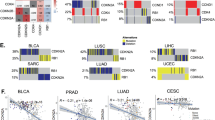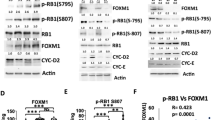Abstract
The retinoblastoma (RB) gene is one of the most extensively studied tumour-suppressor genes1. Deletion or inactivation of both RB alleles is an essential, rate-limiting step in the formation of retinoblastoma and osteosarcoma that arise in families that carry mutant RB (ref. 2). RB inactivation is also found in other human tumours3,4,5,6,7,8. Whereas loss of RB function is associated with the loss of cellular proliferative control, introduction of a wild-type RB can suppress cell growth and tumorigenicity5,9,10,11,12. Thus, identification of factors that interfere with and/or control the function of the RB protein is critical for understanding both cell-cycle control and oncogenesis. Here we describe a new gene, Bog (for B5T over-expressed gene), which was identified and shown to be overexpressed in several transformed rat liver epithelial (RLE) cell lines resistant to the growth-inhibitory effect of TGF-ß1, as well as in primary human liver tumours. The Bog protein shares homology with other retinoblastoma-binding proteins and contains the Rb-binding motif LXCXE. Using the yeast two-hybrid system and co-immunoprecipitation, we demonstrated that Bog binds to Rb. In vivo, Bog/Rb complexes do not contain E2F-1, and Bog can displace E2F-1 from E2F-1/Rb complexes in vitro. Overexpression of Bog in normal RLE cells conferred resistance to the growth-inhibitory effect of TGF-ß1. Furthermore, normal RLE cells are rapidly transformed when Bog is continuously overexpressed and form hepatoblastoma-like tumours when transplanted into nude mice. These data suggest that Bog may be important in the transformation process, in part due to its capacity to confer resistance to the growth-inhibitory effects of TGF-ß1 through interaction with Rb and the subsequent displacement of E2F-1.
This is a preview of subscription content, access via your institution
Access options
Subscribe to this journal
Receive 12 print issues and online access
$209.00 per year
only $17.42 per issue
Buy this article
- Purchase on Springer Link
- Instant access to full article PDF
Prices may be subject to local taxes which are calculated during checkout




Similar content being viewed by others
References
Weinberg, R.A. Tumor suppressor genes. Science 254, 1138– 1146 (1991).
Benedict, W.F. Patient with 13 chromosome deletion: evidence that the retinoblastoma gene is a recessive cancer gene. Science 219, 973– 975 (1983).
Lee, E.Y. et al. Inactivation of the retinoblastoma susceptibility gene in human breast cancers . Science 241, 218–221 (1988).
Horowitz, J.M. et al. Frequent inactivation of the retinoblastoma anti-oncogene is restricted to a subset of human tumor cells. Proc. Natl Acad. Sci. USA 87, 2775–2779 (1990).
Bookstein, R., Shew, J.Y., Chen, P.L., Scully, P. & Lee, W.H. Suppression of tumorigenicity human prostate carcinoma cells by replacing a mutated RB gene. Science 247, 712–715 (1990).
Yokota, J. et al. Altered expression of the retinoblastoma (RB) gene in small-cell carcinoma of the lung. Oncogene 3, 471– 475 (1988).
Venter, D.J. et al. Retinoblastoma gene deletions in human glioblastomas. Oncogene 6, 445–448 ( 1991).
Cheng, J. et al. Homozygous deletion of the retinoblastoma gene in an acute lymphoblastic leukemia (T) cell line. Blood 3, 730– 735 (1990).
Huang, H.-J.S. et al. Suppression of the neoplastic phenotype by replacement of the RB gene in human cancer cells. Science 242, 1563– 1566 (1988).
Takahashi, R. et al. The retinoblastoma gene functions as a growth and tumor suppressor in human bladder carcinoma cells. Proc. Natl Acad. Sci. USA 88, 5257–5261 (1991).
Qin, X.-Q., Chittenden, T., Livingston, D.M. & Kaelin, W.G. Identification of a growth suppression domain within the retinoblastoma gene product. Genes Dev. 6, 953–964 ( 1992).
Goodrich, D.W., Wang, N.P., Qian, Y.W., Lee, E.Y. & Lee, W.H. The retinoblastoma gene product regulates progression through G1 phase of the cell cycle. Cell 67, 293–302 (1991).
Laiho, M., DeCaprio, J.A., Ludlow, J.W., Livingston, D.M. & Massague, J. Growth inhibition by TGF-beta linked to suppression of retinoblastoma protein phosphorylation. Cell 62, 175–185 (1990).
Zerfass, K. et al. Cell cycle-dependent disruption of E2F-p107 complexes by human papillomavirus type 16 E7. J. Gen. Virol. 76, 1815– 1820 (1995).
Huggett, A.C. et al. Development of resistance to the growth inhibitory effects of transforming growth factor beta 1 during the spontaneous transformation of rat liver epithelial cells. Cancer Res. 51, 5929– 5936 (1991).
Barrack, E.R. TGF-beta in prostate cancer: a growth inhibitor that can enhance tumorigenicity. Prostate 31, 61–70 ( 1997).
Padgett, R.W., Savage, C. & Das, P. Genetic and biochemical analysis of TGF beta signal transduction. Cytokine Growth Factor Rev. 8, 1– 9 (1997).
Namba, M., Mihara, K. & Fushimi, K. Immortalization of human cells and its mechanisms. Crit. Rev. Oncog . 7, 19–31 ( 1996).
Whyte, P. et al. Association between an oncogene and an anti-oncogene: the adenovirus E1A proteins bind to the retinoblastoma gene product. Nature 334 , 124–129 (1988).
Lee, W.-H. et al. Human retinoblastoma susceptibility gene: cloning, identification and sequence . Science 235, 1394–1399 (1987).
Bernards, R. et al. Structure and expression of the murine retinoblastoma gene and characterization of its encoded protein. Proc. Natl Acad. Sci. USA 86 , 6474–6478 (1989).
Bruno, E. et al. The Smad5 gene is involved in the intracellular signaling pathways that mediate the inhibitory effects of transforming growth factor-beta on human hematopoiesis . Blood 91, 1917–1923 (1998).
Altiok, A. Effect of transforming growth factor-beta 1 and -beta 2 on the proliferation of Burkitt lymphoma and lymphoblastoid cell lines. Growth Factors 4, 117–128 (1991).
Gryfe, R. et al. Molecular biology of colorectal cancer. Curr. Probl. Cancer 21, 233–300 (1997).
Piacibello, W., Severino, A., Stacchini, A. & Aglietta, M. Differential effect of transforming growth factor beta 1 on the proliferation of human lymphoid and myeloid leukemia cells. Haematologica 76, 460–466 (1991).
Garfield, S., Huber, B.E., Nagy, P., Cordingley, M.G. & Thorgeirsson, S.S. Neoplastic transformation and lineage switching of rat liver epithelial cells by retrovirus-associated oncogenes. Mol. Carcinog. 1, 189–195 (1988).
Acknowledgements
We would like to thank V. Factor and P.J. Wirth for their review and comments, and R. Hong for his assistance in the laboratory.
Author information
Authors and Affiliations
Corresponding author
Rights and permissions
About this article
Cite this article
Woitach, J., Zhang, M., Niu, CH. et al. A retinoblastoma-binding protein that affects cell-cycle control and confers transforming ability. Nat Genet 19, 371–374 (1998). https://doi.org/10.1038/1258
Received:
Accepted:
Issue Date:
DOI: https://doi.org/10.1038/1258
This article is cited by
-
Genome-wide siRNA screens identify RBBP9 function as a potential target in Fanconi anaemia-deficient head-and-neck squamous cell carcinoma
Communications Biology (2023)
-
Mechanism-based traps enable protease and hydrolase substrate discovery
Nature (2022)
-
Identification of immunogenic proteins of the cysticercoid of Hymenolepis diminuta
Parasites & Vectors (2017)
-
Comparative transcriptomics reveals similarities and differences between astrocytoma grades
BMC Cancer (2015)
-
A high-throughput, multiplexed assay for superfamily-wide profiling of enzyme activity
Nature Chemical Biology (2014)



